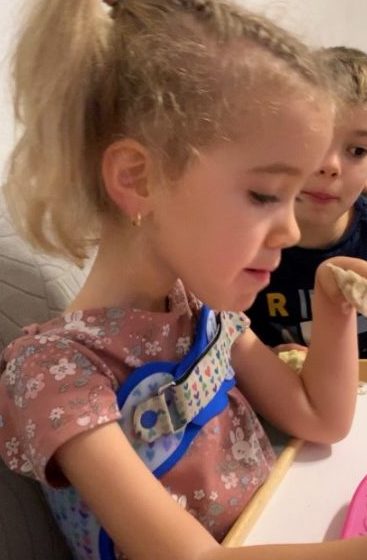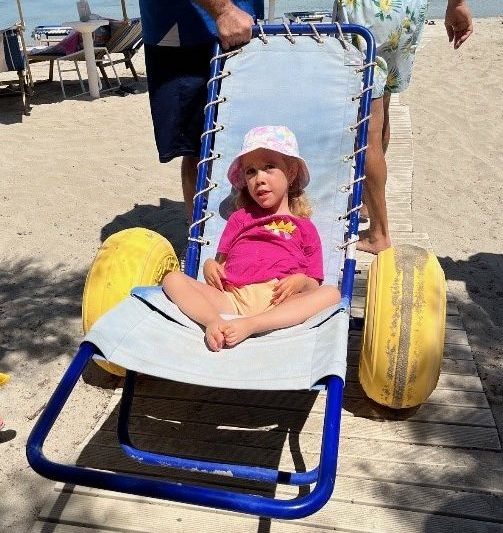JOY
Becoming a parent for the first time is indescribable. To be pregnant for the second time brings new joy, especially after an uncomplicated and carefree pregnancy.
On 28.12.2018, our darling Emily was born.
The anticipation of seeing our Emily grow up with her older brother Ethan gave us a feeling of happiness. Watching them having fun together, playing together and supporting each other as siblings warmed our hearts. But then…


DOUBTS
After the first few months, we noticed that Emily didn’t move very much, but we were told that this was just a minor developmental delay.
Our worries increased when we noticed that our daughter always cried when we put her on her stomach and that she could not lift her head or turn around.
Her tongue almost always stuck out of her mouth a little, she had little energy, got tired easily, couldn’t lift her arms to reach for things and wouldn’t roll over onto her back – let alone crawl… We were also told that this was due to muscular hypotonia.
When Emily was nine months old, we decided to take matters into our own hands and have her undergo a neurological examination. All our fears came true: we now know that our daughter has a problem, but what is it?
ODYSSEUS
We started with a genetic test that showed a 47% chance of mitochondriopathy. Put simply, the mitochondrion is the 'engine' of our cells. When the engine fails, there is little energy available.
There is no cure, only symptomatic therapy with vitamins (especially B2 or riboflavin), which taste unpleasant and which our little girl did not like to take.
Months went by and Emily's motor condition worsened. She became easily ill, suffering mainly from respiratory infections, which manifested themselves in a variety of symptoms. She was also unable to cough because she lacked the strength to do so - and then she stopped eating.
From that moment on, the first of many hospitalisations began, with the insertion of a nasogastric tube to ensure adequate hydration and nutrition.


UNCERTAINTY
However, when we read the symptoms of mitochondriopathy, we realised that there were inconsistencies with the symptoms we saw in Emily: In some ways, her signs were different, even worse than described.
At this point, the doctors advised us to go to the Besta Paediatric Neurocentre in Milan to carry out a series of diagnostic tests (magnetic resonance imaging, electroencephalogram, muscle biopsy, etc.).
However, after the first visit, we encountered another obstacle - the Covid-19 pandemic. As a result, the Besta Clinic in Milan stopped accepting patients from abroad. During all these months, when our daughter (who fortunately has no cognitive deficits) was not suffering from infections, she regularly underwent physiotherapy in and out of the water, in order to slow down the progression of the muscular contractions caused by the worsening of the disease, which at that time we did not know exactly what it was.
DESPONDENCY
Discouraged, and almost two years after the first neurological examination, we asked our specialist for a second opinion, but he doubted that any doctor in Switzerland would recognise such a rare disease as Emily's and that we should wait for the situation with Covidien to improve before contacting the Besta Clinic in Milan again.
But we didn't have the patience to wait any longer.
I was working as a general practitioner at the Neurocentre in Lugano at the time and asked my chief physician, Dr Städler, for help. He put me in touch with a former colleague of his, Dr Datta, a neuroepileptologist at the Basel Children's Hospital UKBB.
This was the first stroke of luck in all the tragic events: Within a week, a neurological examination was arranged at the Basel Children's Hospital with Mrs Prof Dr Klein, a European specialist in neuromuscular diseases, the very condition Emily was diagnosed with. It took her just five minutes with our daughter to give us the devastating diagnosis:
Merosin-deficient congenital muscular dystrophy LAMA2.

MEROSIN-DEFICIENT CONGENITAL MUSCULAR DYSTROPHY; also known as LAMA-2
However, to confirm the diagnosis, more specific tests were needed than the 'simpler' genetic tests we had done two years earlier. At that time, they had been done as a screening test and were therefore of lower quality. An MRI (magnetic resonance imaging) of the brain and a muscle biopsy were arranged.
So, we gave Emily the two tests mentioned above - both under general anaesthetic.



CONFIRMATION
The results of the diagnostic tests carried out confirmed the diagnosis made by Mrs Prof Dr Klein.
Specific genetic tests showed that we, Emily's mother and father, are healthy carriers of the disease. As it is inherited as an autosomal recessive trait, there was a one in four chance that one of our children would develop the condition.
After two years of back and forth, we were grateful to finally have an accurate diagnosis of our daughter's condition. Now, however, a new deep sadness filled our hearts as we realised that this was an incurable disease.
FIGHT
While other children spend their time on the playground, having fun, socialising, playing sports or engaging in other activities, Emily's day consists mainly of visits to the doctor and physiotherapy sessions.
She has to undergo annual orthopaedic examinations to monitor her muscle contractions and the scoliosis that is inevitably developing. There are also numerous cardiological, pulmonological, neurological, ophthalmological and nutritional examinations, including analyses of sleep disorders due to the risk of respiratory arrest.
All this is in addition to the regular paediatric check-ups and the three weekly sessions of occupational therapy and physiotherapy - two in the swimming pool and one on the gymnastics mat.



RESILIENCE
Children should have fun in the playground every day, swinging, sliding, playing hide and seek, riding bikes or scooters.
They should be running around, playing hide and seek, rolling in the grass and doing somersaults. Emily, on the other hand, has to wear splints on her arms, wrists, legs and feet every day, a corset and a neck brace, and stand on the static therapy stand every day.



She has to be pushed in a wheelchair or use an electric wheelchair to get around. Sitting, showering or going to the toilet is only possible with special aids.



GRATITUDE
Despite our dejection and melancholy, there are small satisfactions.
During this bitter, gruelling and painful journey, we have met many wonderful people who have helped us with Emily's development and who have grown to love her - and Emily has grown to love them.
Fortunately, our daughter has no cognitive problems; on the contrary, she has been recognised as having an above average intellect.
She was accepted into the integrative playgroup "La Girandola" and has adapted very well and later she was enrolled in the kindergarten, both in the community where we live. With the help of Paola, an educational integration assistant, Emily was able to take part in the normal kindergarten routine and now in a normal school, as Paola helps her to overcome the difficulties caused by her muscular disease.


HOPE
Nothing in life prepares you for your child's illness.
There are many moments of exhaustion, discouragement and sadness, soaked in many tears. Especially when Emily says words like "I'll never be able to walk" or "I'm disabled" or "I'll never be able to do this". Each time our blood freezes in our veins.
Yet she feels valued and loved by her parents, brother, grandparents, aunts, uncles, school friends, doctors and therapists. Because when we ask Emily if she is happy, she gives us her unmistakable, enchanting smile and answers YES. That gives us strength every day.
We hope that one day, thanks to research, we will be able to make Emily's dream come true. The dream of WALKING, the dream of independence, so that she can walk independently and hug all the people who love and support her.












Mummy, Ethan, Emily, Daddy
